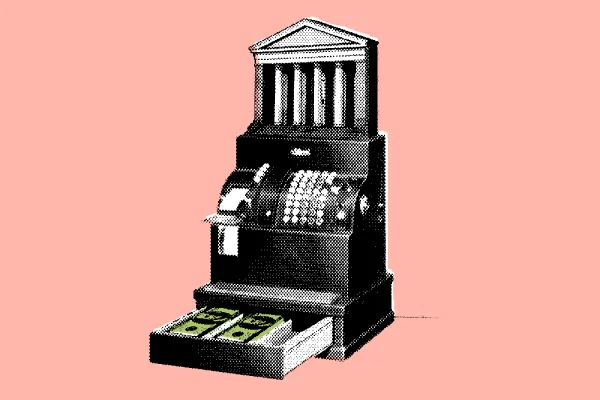The unprecedented events of 2001 nearly matched the worst-case scenarios for many markets. But derivatives survived , they even thrived.
By Nina Mehta
February 2002
Institutional Investor Magazine
In September and October J.P. Morgan traded more credit derivatives than cash bonds, a first for the $800 billion bank. Derivatives experts had always suspected that their markets would prove more liquid than the underlying market in a time of crisis, and the tragedy of September 11 proved them right.
"Liquidity dried up to nothing because of settlement problems with cash bonds, but the volume of credit derivatives increased substantially," says William Demchak, who runs J.P. Morgan's global structured finance and credit portfolio activities.
The derivatives markets have long promised to provide critical liquidity and limit risk in tough times. The wrenching events of 2001 demanded that they deliver. Global equity markets dropped more than 17 percent. The U.S. fell into recession, towing along much of the rest of the world. Global corporate defaults, at $110 billion, hit a ten-year high. Such well-known names as Finova Capital Corp.; Lucent Technologies; Pacific Gas & Electric Co.; Railtrack Group; Sabena; Swissair's parent, SAirGroup; Xerox Corp.; and, most notoriously, Enron Corp. suffered major credit problems and, in some cases, bankruptcy.
The bad news wasn't confined to corporations. In the midst of a banking crisis, Turkey had to devalue its currency last February and was in mid-January still trying to persuade the International Monetary Fund to grant more than $10 billion in new loans. Argentina dissolved in social and political chaos before defaulting on its massive $132 billion in public debt. Trying gamely to keep the U.S. economy moving, the Federal Reserve Board cut interest rates an unprecedented 11 times, to a 40-year low. The September terrorist attacks not only drastically reduced bond market liquidity but closed the U.S. stock markets for four days, the longest shutdown since World War I.
Not many worst-case scenarios included so many serious shocks to the global financial system. "It was the year we threw out the playbook," says Philip Ruffat, a Eurodollar futures trader and senior vice president at Fuji Futures Co.
In such a volatile environment, virtually all roads led to the derivatives markets, "the most efficient way" to respond to crises, says Joanne Hill, who oversees equity derivatives research at Goldman, Sachs & Co. For example, many pension funds for public employees, whose boards require them to maintain a target weighting in equities relative to bonds, suddenly found themselves underweighted as the stock market plummeted after September 11. They turned to futures, exchange-traded funds and call options on broad-based indexes to bolster their U.S. equity exposure. Goldman, says Hill, identified $10 billion to $15 billion of such pension buying in October alone. "While 2000 was more of a bottom-up market with huge growth in single-stock options, with volatility at the stock level and in some sector products, in 2001 for the first time we began to see growth in the broad-based index products," notes Hill.
The changing appetite for risk among capital markets participants also reduced other exposures. For instance, the default of the emerging markets' largest debt issuer, Argentina, didn't upend other developing countries. In part that's because the country's problems were evident nearly a year in advance, giving investors ample time to lighten their holdings. Leverage was down as well, and nations like Brazil tightened fiscal discipline, prompting investors to distinguish between countries, rather than viewing the emerging markets as a bloc. Tougher credit conditions made it costlier to borrow, but access to the capital markets didn't disappear, and credit spreads didn't widen evenly across countries.
"The fact that there were no catastrophes in the derivatives market last year proves that a lot of the work done post-1998 to reduce risks was fruitful," says Michael Pohly, manager of Morgan Stanley's North American credit derivatives business. "Counterparty exposure in particular became more important and was more widely managed."
All this pushed last year's derivatives volumes to new highs. The aggregate notional value of exchange-traded contracts rose 6 percent from the second quarter to a record $150 trillion in the third quarter. (By the end of the third quarter, total 2001 turnover, at $430 trillion, had surpassed 2000's full-year level of $384 trillion.) Over-the-counter market volume grew 4 percent in the first half of the year above the comparable period of 2000, hitting $98.8 trillion in notional value, according to the most recent statistics from the Bank for International Settlements. Interest rate derivatives turnover, at $75.9 trillion, accounted for the majority of the OTC activity. The notional value of foreign exchange and interest rate contracts expanded by 8 and 4 percent, respectively. And volume in credit derivatives continued to soar, reaching $693 billion at the end of June, up more than sixfold from the $108 billion of three years earlier, according to the BIS's triennial statistics.
Investors are driving the surging volume through an ever-smaller number of major dealers. Such mergers in the banking industry as J.P. Morgan's December 2000 union with Chase Manhattan Corp. have thinned the ranks and helped shape the rankings of Institutional Investor's eighth annual derivatives survey. In 2001 major clients , corporations, government agencies, institutional investors and U.S. and foreign hedge funds , largely redrew the standings of the leading derivatives players. Most notably, Goldman, Sachs & Co. edged out Citigroup/Salomon Smith Barney for first place, dislodging Citi from the top slot for the first time since 1996. The combined J.P. Morgan climbed to the third position (J.P. Morgan and Chase Manhattan Corp. were previously Nos. 7 and 8, respectively).
The heftier trading volumes weren't solely the result of myriad catastrophes. With the Fed aggressively cutting rates all year long, much of 2001's activity occurred in fixed income.
"The Fed cuts made it a conducive trading environment for ourselves and our clients," says J.P. Morgan's Demchak. "We've seen a lot of flow activity as a function of repositioning as the Fed cut rates. Mortgage refinancing activity also drove a lot of issuance out of the U.S. [mortgage] agencies." The result: a boost in interest rate swaps activity and short-term money market derivatives trading.
The activity wasn't confined to the U.S. As the euro-denominated capital markets continue to expand, a new credit culture has taken hold in Europe. "Investors have been setting up a capability to understand and invest in credit, whereas before they just bought the supranationals and sovereigns and traded the currency risk," says Demchak. "At the same time, the banking community in Europe, prompted by more stringent capital accords, has started to follow the U.S. model of originating credit and distributing it to investors." This should pave the way for banks to actively manage their credit portfolios, using credit derivatives to reduce risk or improve performance by transferring assets on and off the balance sheet.
Dealers have also been quick to latch on to one of the capital markets' few growth engines: hedge funds, which saw their assets rise to $514 billion last year from $487 billion the year before, according to analysts at Hedge Fund Research in Chicago. RBC Capital Markets, Société Générale and Zurich Capital Markets aggressively pushed principal-protected structured products linked to hedge funds. Like the underlying instruments, these products offer investors enhanced yield and diversification, two particularly attractive qualities in an environment marked by low bond rates and shaky equity market fundamentals.
SocGen has managed accounts with about 80 hedge funds through its subsidiary Lyxor Asset Management. Pension funds, insurers and other investors can choose the funds they'd like to participate in based on their own risk-return preferences. SocGen then builds a customized product, typically a note with a maturity between three and 12 years, linked to a dedicated fund that invests in the selected managed accounts. Investors can add leverage and opt for a strategy that uses a form of portfolio insurance to dynamically manage their exposure. "Each managed account could be seen as a piece of Lego, and investors assemble the Legos as they please," says Stanislas Debreu, who runs global sales and marketing for SocGen's equity derivatives group.
Will the rapid growth continue in 2002? There's at least one dark cloud. The stunning collapse of Houston-based energy giant Enron into the world's biggest bankruptcy will likely unsettle portions of the marketplace. The major OTC derivatives markets player disintegrated when Enron's collection of toxic off-balance-sheet financing deals eroded its creditworthiness with investors and in the eyes of the rating agencies. Standard & Poor's estimated in November that total credit exposure to Enron (in the form of debt, loans and financings, both on and off balance sheet) exceeded the firm's $33 billion balance sheet, while direct exposure in the credit derivatives market stood at $3.3 billion. Banks, insurers and Enron's entire client base are on the hook for billions of dollars.
The immediate impact of the company's demise was seen in ballooning credit spreads in the energy and financial sectors, along with those on credit derivatives. About the time of the bankruptcy filing, the market for default protection on Dynegy, one of Enron's main rivals and, briefly, a bidder for the firm, nearly dried up as sellers of protection refused to trade.
Still, by most accounts, the market had functioned as it was designed to, by enabling counterparties to lay off credit risk in the capital markets. No single bank appears to "have excessive exposure to Enron on their derivatives book," says Morgan Stanley's Pohly. Hundreds of credit derivatives contracts written on Enron's name, which banks and insurers had bought to protect against a potential default, have been settled for cash without mishap.
Even so, counterparties to Enron in its natural gas, power and commodities derivatives trading business, as well as counterparties to credit derivatives and interest rate swaps trades with Enron, have liabilities in the billions of dollars. Enron's demise has also taken a toll on a number of collateralized debt obligations and synthetic CDOs. Moody's Investors Service downgraded $500 million of CDO products with exposure to Enron and noted that several European CDOs were particularly vulnerable, even though Enron presented "limited" risks to the overall asset class.
But although the use of credit derivatives contained individual exposure to Enron, banks, most notably J.P. Morgan Chase & Co. and Citigroup, had large exposures on their loan and insurance books as well as in their surety businesses. In part because of Enron, J.P. Morgan Chase reported a $332 million loss for the fourth quarter.
"In the future, banks and insurance companies won't allow themselves to be extended for $3 billion across nine to ten different business units without aggregating it somewhere and saying that's too much exposure to one company," notes Pohly.
The Enron debacle has prompted calls for more complete corporate disclosure , and quicker and better informed responses from rating agencies. "One of the things the rating agencies didn't appreciate was the degree to which a liquidity crisis could be triggered at Enron as a result of the structured deals it had issued," says James Forese, head of Citigroup's global interest rate and derivative products group. Moody's and S&P's have said they are mulling over changes in light of the Enron problems.
To most credit derivatives dealers, however, the Enron catastrophe has only strengthened the case for their product. "The trend is only going one way," says Forese. "More people will use credit derivatives products, not fewer. We haven't seen anyone who was using them at the start of the year who isn't using them now."
Senior Editor Jane B. Kenney compiled the statistics that appear in this feature.
To read more news on derivatives, go to Derivatives Week
To read more research articles on derivatives, go to the Journal of Derivatives





